
Barge often refers to a flat-bottomed inland waterway vessel which does not have its own means of mechanical propulsion. The first modern barges were pulled by tugs, but on inland waterways, most are pushed by pusher boats, or other vessels. The term barge has a rich history, and therefore there are many other types of barges.

British Waterways, often shortened to BW, was a statutory corporation wholly owned by the government of the United Kingdom. It served as the navigation authority for the majority of canals and a number of rivers and docks in England, Scotland and Wales.
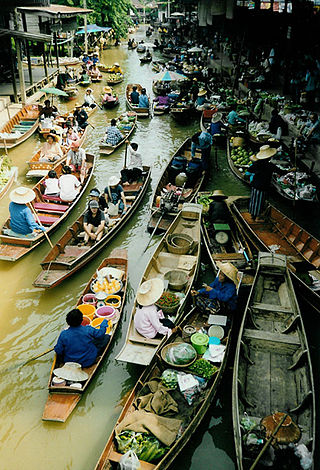
A waterway is any navigable body of water. Broad distinctions are useful to avoid ambiguity, and disambiguation will be of varying importance depending on the nuance of the equivalent word in other languages. A first distinction is necessary between maritime shipping routes and waterways used by inland water craft. Maritime shipping routes cross oceans and seas, and some lakes, where navigability is assumed, and no engineering is required, except to provide the draft for deep-sea shipping to approach seaports (channels), or to provide a short cut across an isthmus; this is the function of ship canals. Dredged channels in the sea are not usually described as waterways. There is an exception to this initial distinction, essentially for legal purposes, see under international waters.

Regent's Canal is a canal across an area just north of central London, England. It provides a link from the Paddington Arm of the Grand Union Canal, 550 yards (500 m) north-west of Paddington Basin in the west, to the Limehouse Basin and the River Thames in east London. The canal is 8.6 miles (13.8 km) long.
The British Transport Commission (BTC) was created by Clement Attlee's post-war Labour government as a part of its nationalisation programme, to oversee railways, canals and road freight transport in Great Britain. Its general duty under the Transport Act 1947 was to provide an efficient, adequate, economical and properly integrated system of public inland transport and port facilities within Great Britain for passengers and goods, excluding transport by air.
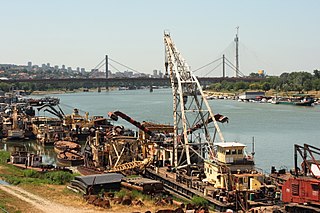
A riverboat is a watercraft designed for inland navigation on lakes, rivers, and artificial waterways. They are generally equipped and outfitted as work boats in one of the carrying trades, for freight or people transport, including luxury units constructed for entertainment enterprises, such as lake or harbour tour boats. As larger water craft, virtually all riverboats are especially designed and constructed, or alternatively, constructed with special-purpose features that optimize them as riverine or lake service craft, for instance, dredgers, survey boats, fisheries management craft, fireboats and law enforcement patrol craft.

The canals of the United Kingdom are a major part of the network of inland waterways in the United Kingdom. They have a varied history, from use for irrigation and transport, through becoming the focus of the Industrial Revolution, to today's role of recreational boating. Despite a period of abandonment, today the canal system in the United Kingdom is again increasing in use, with abandoned and derelict canals being reopened, and the construction of some new routes. Canals in England and Wales are maintained by navigation authorities. The biggest navigation authorities are the Canal & River Trust and the Environment Agency, but other canals are managed by companies, local authorities or charitable trusts.

The modern terms short-sea shipping, marine highway, and motorways of the sea, and the more historical terms coastal trade, coastal shipping, coasting trade, and coastwise trade, all encompass the movement of cargo and passengers mainly by sea along a coast, without crossing an ocean.

La Belle Epoque is a barge of the Belgian spits category. She was built in 1930 to carry (mainly) timber. Renovated in 1995, she operates as a hotel barge on the Burgundy Canal in central France.
Seagull Trust Cruises is a waterway society and Scottish charity.

Anjodi was built to carry freight on the waterways of the Netherlands, Belgium and France but has been converted to a hotel barge.

A hotel barge is a barge that has been built or converted to serve as a hotel or other kind of lodging. Hotel barges are generally found on rivers and canals in Europe, and may be used for river cruises or permanently moored in one place.
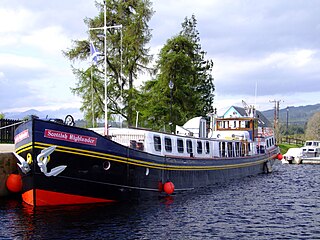
The Scottish Highlander is a boutique hotel barge cruising the Caledonian Canal in Scotland, from Inverness to Fort William. She is a Luxe motor Dutch steel barge. She is a member of the fleet of hotel barges owned by European Waterways.

The L'Impressionniste was built in 1960 in Belgium and is a spits barge with a Dutch luxe motor-style bow. The overall hull shape of the barge is a marriage of the French and Dutch barge building influences. She was converted to a hotel barge in 1996. L'Impressionniste is owned and operated by European Waterways and sails on the Canal de Bourgogne in France.
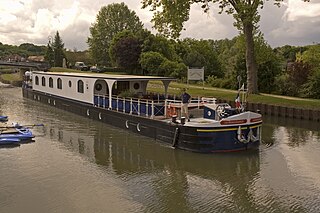
La Renaissance was built in Belgium in 1960 as a standard péniche barge to carry cargo along the canals of Europe. Her original cargo was grain and iron ore. She presently serves as a hotel barge, owned and operated by European Waterways. She is one of around 60 barges offering luxury cruises on French waterways.
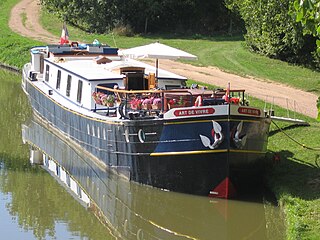
The L'Art de Vivre was built in 1917 in Deptford, England, as a cargo barge but currently serves as a luxury hotel barge owned and operated by European Waterways. She is one of around 60 hotel barges operating on European waterways, mostly on the smaller French canals.

The La Dolce Vita was built in 1897 in Groningen, Netherlands. She originally served as a cargo barge in the Netherlands. She presently serves as a hotel barge, owned by Giampaolo Friso.

Rosa is a French hotel barge of Dutch origin. Since 1990 she has been offering cruises to international tourists on the Canal de Garonne in the Nouvelle Aquitaine region of South West France. The waterway authority Voies Navigables de France reported in 2014 that there were around 80 hotel barges operating on the inland waterways. They keep alive the tradition of the boatmen (mariniers) whose numbers have declined in number from thousands in the post-World War II years to just a few hundred today.
The Luciole is a converted French barge, or péniche. She was built in 1926. In 1966 she became the first hotel barge on the French canal system. She now operates on the Canal du Nivernais and River Yonne, her home mooring is in Auxerre.
Les Bateaux Belmond is a group of seven canal barges or péniche-hôtels that are part of the Belmond collection of around 50 international hotels, trains and river cruises. Formally known as Afloat in France, the barges offer cruises on canals and rivers in the French regions of Burgundy, Franche-Comté, Saône, Provence, Vallée du Rhône, Midi-Pyrénées and Camargue, while the Alsace and Champagne regions are added in 2018. The barges carry up to 12 passengers. The barges visit towns and cities including Dijon, Besançon, Carcassonne, Arles, Nancy and Strasbourg. There are stops at countryside sites of interest en route.
















